Menus
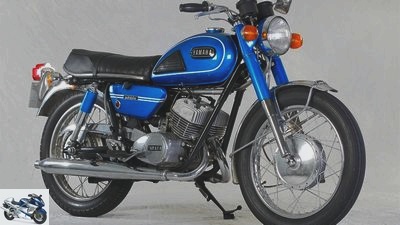
www.bilski-fotografie.de
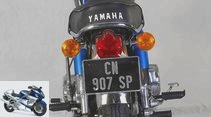
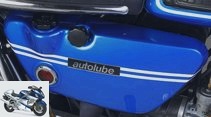
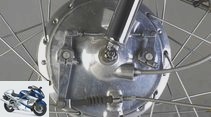

11 photos

www.bilski-fotografie.de
1/11
The two-stroke still cuts a fine figure today.
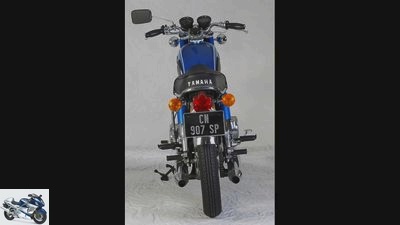
www.bilski-fotografie.de
2/11
With a sportier, less cranked handlebar and a slim silhouette, the DS-6 cuts a fine figure from every perspective.
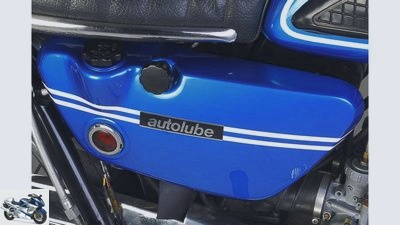
www.bilski-fotografie.de
3/11
The 2.4 liter oil tank of the “Autolube” separate lubrication is located in the fold-out right side cover.
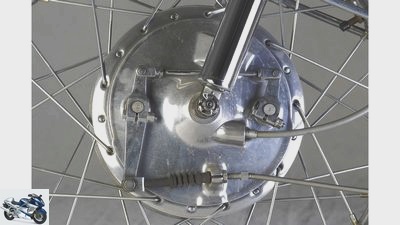
www.bilski-fotografie.de
4/11
The lever for operating the 180 mm duplex drum brake at the front is now on the left.
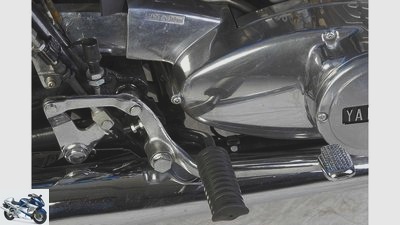
www.bilski-fotografie.de
5/11
Elaborate: the redirection of the foot brake lever.

www.bilski-fotografie.de
6/11
A smart concession to everyday practice: the air pump mounted under the tank.
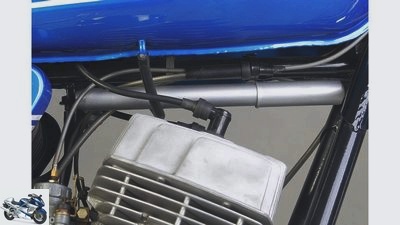
www.bilski-fotografie.de
7/11
… that the powerful 250 in the DS-6 keeps a cool head even at full power.
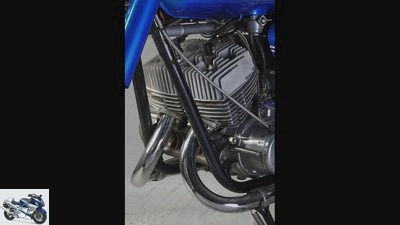
www.bilski-fotografie.de
8/11
Yamaha takes care of this by means of newly designed cooling fins that offer more cooling surface, …
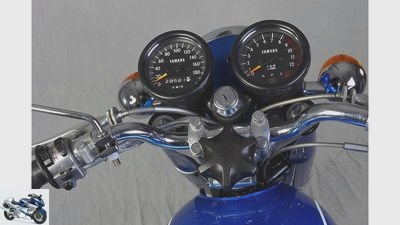
www.bilski-fotografie.de
9/11
The speedometer and tachometer work as separate clocks.
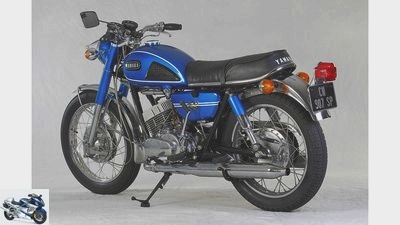
www.bilski-fotografie.de
10/11
The DS-6 (D stands for the displacement of 250 cm³, S for sport) lives up to its designation with a smaller, teardrop-shaped tank and elongated side covers.

www.bilski-fotografie.de
11/11
The two conical exhaust pipes are also new.
In the studio: Classic Yamaha DS-6 bike
Blue miracle
The almost 28 hp two-stroke engine of the handy Yamaha DS-6 ensured fast performance. The sporty, elegant classic still cuts a fine figure in the studio.
It was a long road with many developmental stages leading to the one shown here Yamaha DS-6, which appeared in 1969 and heralded the 1970s in terms of design.
Buy complete article
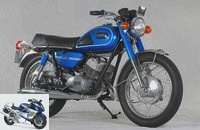
In the studio: Classic Yamaha DS-6 bike
Blue miracle
3 After three there is five in Japan
It followed – no, not the YDS4. The four in the name has already been skipped in other model series, because for the traditionally superstitious Japanese, this number promises bad luck and death. So in 1967 the YDS5E followed in the footsteps of the YDS3. The E stands for the newly introduced electric starter, a Dyna system acts as a starter and alternator at the same time. On the engine side, the slightly modified YDS5E “Minor” version of the following year 1968 with the introduction of the five-channel gas control system laid the foundation for the extremely powerful engine of the Yamaha DS-6.
This DS-6, which is sometimes even treated as a slightly different successor to the YDS5E in the list of the 250 models, has a lot more to offer. The twin, fed by two 26-series Mikuni carburettors, with a modified shape and routing of the five transfer channels and a modified exhaust system, now in the original version (with “America exhaust system”) supposedly produced a proud 30 hp, with the silencers for the German version at least still respectable, 27.5 hp measured by the Technical University in Braunschweig for the sample report. In fact, however, this difference is more likely due to the different measurement methods and in truth only exists on paper.
Newly designed cooling fins ensure an enlarged cooling surface and should help the engine to keep a cool head. Tester Klacks Leverkus was once visibly impressed in the test by the improved acceleration from medium speeds, as well as by the increased maneuverability, in the lower gears even up to 8500 rpm.
4 DS-6 chassis absolutely at the height
By eliminating the apparently dispensable electric starter, not only was weight saved, but a smaller battery (5 Ah instead of 11 Ah) could also be used. The tank volume was also saved – the new fuel barrel only holds 11 liters instead of the previous 15 liters and beguiles with its slim teardrop shape instead of the once rather clumsy design, but did not arouse pure enthusiasm in view of the severely limited range. After all, an ambitious driver also likes to chase around nine liters per 100 kilometers through the Mikuni carburettors. The flatter, more elongated-looking side covers and the less cranked handlebars underline the sporty attitude of the newcomer, while the modified fittings with separate housings for the speedometer and rev counter already point the way to the future in terms of design. The two paint finishes Adrian Blue and Brilliant Red also go perfectly with the classy, elegant appearance.
Not only the drive convinced the tester at the time (“Not only the performance is impressive, but also the vibration-free and extremely smooth running of the engine”), the Yamaha DS-6 was also absolutely up to date when it comes to the chassis. The short wheelbase of just 1290 millimeters gave the 250 series great maneuverability, and the Yamaha was praised as a “nimble sprinter for short, winding courses”. But the DS-6 also shone on long straights, namely with the respectable top speed of almost 160 km / h. Only the somewhat hard struts and the still too big jump between fourth and fifth gear, which is sometimes derided as “overdrive”, received slight criticism.
Otherwise, the 2895 Mark expensive Yamaha DS-6 could be seen as a good and fair offer compared to its competitors, including the slightly more expensive Kawasaki A1 and Suzuki T 20. And when a Yamaha with almost 30,000 kilometers on the clock is still doing as well as our photo DS-6 provided by Yamaha Motor Europe, then two-stroke fans will still get shining eyes today. Because how it was once attested in the test: Quality and unpretentiousness are added to the sporty speed. So it’s no wonder that the DS-6 is still so popular with two-stroke classic fans and collectors. If necessary also in red.
Related articles
-
Jahn cult bike Yamaha RD 350 LC Yamaha RD 350 LC The two-stroke theme was through forever. Exhaust gas, noise, yes, yes, it’s okay, must be. Then came the end …
-
Siemers cult bike: Yamaha XS 500 Yamaha XS 500 There was neither internet nor mobile phone, there were not even standard street four-valve engines. Until 1976, then came …
-
www.bilski-fotografie.de cult bike Yamaha XJ 900 From athlete to tourer How comfortable it can be between all chairs, Yamaha demonstrated with the much too …
-
Cult bike Yamaha FZR 1000 Exup
Hartmann cult bike Yamaha FZR 1000 Exup The big hit of 1989 Rarely has a motorcycle been improved so dramatically as the already great …
-
Short test Yamaha XVZ 1300 AT Royal Star Tour Classic
Short test Yamaha XVZ 1300 AT Royal Star Tour Classic revamped Front window, chrome all over and leather case under Sissy’s bar at the back – with good …
-
BMW R 100, Ducati SD 900 Darmah, Yamaha TR 1 classic motorcycle on tour
29 photos bilski-fotografie.de 1/29 On the move with the BMW R 100, the Ducati SD 900 Darmah and the Yamaha TR 1. bilski-fotografie.de 2/29 On the move…
-
fact 20 pictures fact 1/20 The Yamaha XJ 650 found almost 14,000 buyers in Germany from 1980 to 1984, and there are still around 5000 copies in …
-
Comparative test BMW K 1200 LT, Harley-Davidson Electra Glide Ultra Classic, Yamaha XVZ 13 TF Royal Star Venture Beautiful living Eating kilometers, for two, …
-
Gargolov 50 photos Gargolov 1/50 The Yamaha XV 1900 A Midnight Star is the only one to brake without ABS, but with a composite system. Gargolov 2/50…
-
Archive cult bike Yamaha SRX 600 The story of a misjudgment The Yamaha SRX 600 – perhaps the most beautiful standard …